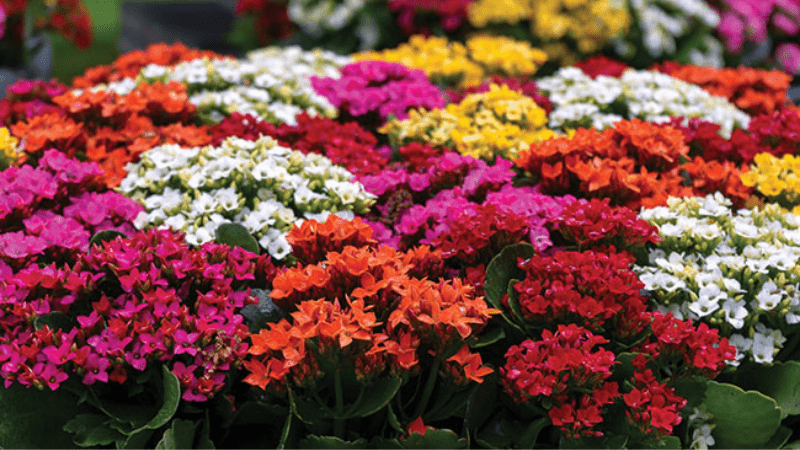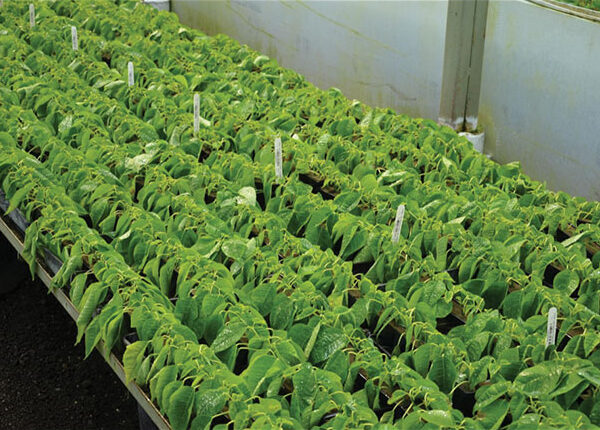
Ornamental floriculture-Part 1
This is part one of a two-part series that will highlight the tools and resources to assist growers with potted flowering and foliage plants and cut flowers.
Growing ornamental floriculture crops, including potted flowering and foliage plants and cut flowers, takes a breadth of knowledge and skill and we rely on countless tools, resources and techniques to get the job done. Some of the most useful tools we have are PGRs. When you first see “PGR,” you probably think of plant growth retardants… when you should be thinking plant growth regulators. There are several PGRs that can help improve floriculture crop production — saving labor and bench time and improving quality and efficiency.
AUXIN
Poinsettia, kalanchoe and chrysanthemum are among the most popular flowering potted and cut crops propagated by stem tip cuttings, as are numerous foliage crops. Indole- butyric (IBA), indole-acetic (IAA) and naphthalene-acetic (NAA) acids all promote rooting; IBA is the most widely used. Traditionally applied as a dip treatment, the basal end of cuttings are quickly placed in IBA in either talcum powder or liquid suspensions before sticking cuttings into propagation substrate and trays or directly into the finishing container.
While dipping cuttings into auxin is a tried-and- true method of applying rooting hormones, new IBA formulations are available to apply the auxin in a foliar spray. The active ingredient is available as a granular (IBA Water Soluble Salts; Hortus) or liquid (Advocate, Fine Americas). The primary advantage to using foliar sprays, as opposed to basal dips, is the labor savings. By not dipping cuttings you will save time and money. An important note is that IBA concentrations appropriate for foliar sprays are not the same a those used for dipping and are often much lower (80 to 400 ppm). The typical application volume for foliar sprays containing PGRs — 2 quarts of final solution per 100 square feet of growing area — is fine for auxin sprays, though higher volumes can be used to promote auxin runoff down the stem. Use the same approach for direct-stuck cuttings as for those in propagation trays.

GIBBERELLIC ACID INHIBITORS
Gibberellic acid synthesis inhibitors are frequently used to inhibit unwanted or excessive stem elongation and produce finished potted plants where the plant is proportional to the container it is in. There are several different active ingredients in this class, including ancymidol (Abide, A-Rest,), chlormequat chloride (Altercel, Citadel), daminozide (B-Nine, Dazide), flurprimidol (Topflor), paclobutrazol (Bonzi, Piccolo, Paczol) and uniconazole (Concise, Sumagic).
The appropriate application method and solution concentration of the different active ingredients varies. Foliar sprays can be used to apply any GA-inhibitor, as they are all taken up by the shoot in leaves (ancymidol, daminozide, chlormequat chloride) or stems (flurprimidol, paclobutrazol and uniconazole). Relatively speaking, daminozide has is the most forgiving active ingredient, which is why it will have the highest recommended concentrations (i.e. 1,250 to 5,000 ppm). Chlormequat chloride has a bit more active compared to daminozide and recommended spray rates are a little less than half (750 to 3,000 ppm) than those for daminozide. The strongest active ingredients are the “triazoles”- ancymidol, flurprimidol, paclobutrazol and uniconazole.
In addition to the site of uptake and degree of activity and affecting what application method and concentration to use, it is important to try and learn about any nuances specific to the crops you are producing that can influence PGR choices. For example, daminozide is an effective active ingredient that can be applied as a foliar spray throughout the entire production period for potted kalanchoe and florist chrysanthemums.
For poinsettia, daminozide is also an effective PGR for controlling height. However, daminozide applications need
to be stopped at the start of short days to avoid negatively influencing bract development. During short days, chlormequat chloride can continue to be sprayed until the start of bract coloration, after which it also cannot be used any longer due. For the rest of the production phase, low- dose drenches of paclobutrazol are useful for controlling unwanted elongation.
ETHEPHON
Ethephon (Collate, Florel, Pistil) is the Swiss Army knife of PGRs. When applied to plants, the ethephon is taken up and once inside the plant cell it starts to generate ethylene. There are several different plant responses to ethylene and we take advantage of these when utilizing ethephon. First, ethylene inhibits cell elongation, and ethephon is commonly used to control height of crops including potted daffodil and hyacinth. Ethylene can also reduce apical dominance and increase branching. Using ethephon to promote branching in poinsettia is called the “Florel Sandwhich,” it is sprayed three to five days before pinching, and then again three to five days after pinching.
When flowers are exposed to ethylene it can promote senescence and abscission; using ethephon early in the production cycle to inhibit unwanted premature flowering can be useful for potted plants such as streptocarpus. Finally, fruit ripening can also be promoted with ethephon and sprays can be made to ornamental peppers to enhance the rate of coloration.
The most important thing to keep in mind when using ethephon is its multi-faceted effects. While controlling height, aborting flowers, ripening fruits can all be good things, they may not be at the same time. For example, while an application of ethephon may be used with the goal of controlling height and increasing branching, it may also negatively affect flowering.
Although ethephon has traditionally been applied as a spray, research has shown that it is also effective when applied as a drench. Up until now, no commercial ethephon product had been labeled for drench applications. However, in early 2024 an updated label for Collate is due out that will include drench applications.

BENZYLADENINE
Benzyladenine (BA) is a cytokinin available commercially as Configure. While cytokinins influence a variety of plant processes, we use it in potted floriculture crop production to improve holiday cactus production. When used during the vegetative phase of production it increases branching and phylloclade number, and when used during inductive short days or cool temperatures it increases flower number. It can also be used to increase the number of offsets in containerized for rosette succulent houseplants such as Eschevaria.
GIBBERELLIC ACID
While we have already discussed those active ingredients that suppress GA production, there is a place in floriculture for applying GA to crops. Cut flowers can benefit from improved stem length, and GA applications can help promote desirable elongation that increases stem value. It can also be used to help improve flowering of several cut flower species including statice and calla lilies. Though it was historically used to hasten flowering of cyclamen, this is no longer necessary with modern cultivars.
GIBBERELLIC ACID + BENZYLADENINE
The combination of GA4+7 and BA7, commercially available as Fascination or Fresco, has several uses in potted flowering and foliage plant production. First, using GA+BA to overcome excessive growth regulation or promote growth is more advisable than using GA alone for potted flowering plants.
Since we are almost always trying to inhibit stem elongation of potted plants, the more measured growth promotion resulting from GA+BA is more desirable than potentially more potent promotion from straight GA. Timing of the GA+BA application can also influence results. For example, to promote plant height in poinsettia it is best used before short days start, whereas to promote bract development and expansion it is better applied during the last few weeks of finishing.

In addition to growth promotion, GA+BA can also be used to inhibit leaf senescence, or lower-leaf yellowing, on potted crops such as lilies during the early season (before budding) or late in production <2 weeks before shipping). When being used to inhibit leaf senescence, only apply to the lower leaves that are at risk of senescing, not the whole plant; unwanted growth promotion could occur if the entire plant is treated.


 Video Library
Video Library 




















